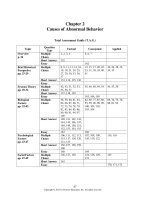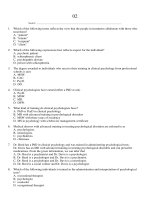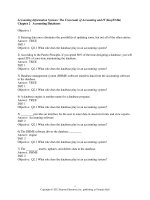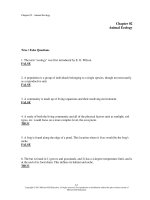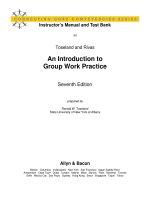Farm management 7th edition kay test bank
Bạn đang xem bản rút gọn của tài liệu. Xem và tải ngay bản đầy đủ của tài liệu tại đây (163.01 KB, 4 trang )
Chap. 2-1
CHAPTER 2
SAMPLE TEST QUESTIONS - MULTIPLE CHOICE
1. Which function of management is concerned with monitoring the results of a decision
and taking corrective action?
a. planning
b. implementation
c. control
d. organization
2. Which of the following shows the proper sequence of management functions as they
would be applied to a specific problem?
a. planning, control, implementation
b. planning, implementation, control
c. control, planning, implementation
d. control, implementation, planning
3. A short summary of why a particular business is in operation is called:
a. internal scanning
b. external scanning
c. a mission statement
d. whole farm plan
4. "Doubling the number of acres farmed in 10 years" is an example of a
a. long-run goal
b. short-run goal
c. mission statement
d. decision
5. Which of the following is an example of a strategic decision?
a. determining fertilizer levels for crops
b. deciding when to sell grain
c. determining what type of business/legal organization to use
d. setting milking times for a dairy
6. Which of the following is an example of a tactical decision?
Chap. 2-2
a.
b.
c.
d.
balancing a livestock ration
forming a partnership with a relative
joining a feeder pig cooperative
installing an irrigation system
7. "What managers do" is best described by which of the following?
a. gather information
b. make decisions
c. analyze data
d. organize the farm
8. External scanning could include assessing
a. the financial condition of the business
b. changes in consumer tastes
c. the basic values of the managers
d. productivity of the farmland owned
9. One characteristic that makes decision making in agriculture different from other types
of business is
a. more government regulation
b. prevalence of very large business units
c. predictability of production processes
d. fixed supply of a major resource
10. The term describing how much time is available to make a decision is
a. imminence
b. revocability
c. frequency
d. importance
11. Which phase of the strategic management process would be most influenced by a farm
family’s basic values and attitudes about agriculture?
a. external scanning
b. internal scanning
c. setting goals
d. strategic development
Chap. 2-3
12. A short summary of why a particular business is in operation is called
a. a whole farm budget
b. internal scanning
c. external scanning
d. a mission statement
SAMPLE TEST QUESTIONS - TRUE/FALSE
T
F 1. Short-run planning is more important than long-run planning.
T F
2. Goals must be known before management decisions can be made.
T
F 3. Because weather and prices are unpredictable, it is impossible to plan more than one
year in advance.
T
F 4. Strategic planning only needs to be done by beginning farmers and ranchers.
T
F 5. No management decision should be made until all possible information has been
acquired.
T
F 6. Maximizing profit is the only goal managers use to make decisions.
T F
T
F 8. Farm and ranch managers can usually set the selling prices for their products.
T F
T
7. More time should be spent on irrevocable decisions than on those which can be
easily reversed.
9. Even choosing the best alternative action will sometimes produce undesirable results.
F 10. Biological production processes are more predictable than industrial production
processes.
T F 11. “Define the problem” is the first step in the decision-making process.
Chap. 2-4
T F
12. Before making any decision, a manager should have a goal(s).
T F
13. The decision-maker must bear responsibility for any decisions made.
T
F 14. Completing all steps in the decision-making process will guarantee a perfect
decision.
T F
15. Management is mostly making decisions.
T
F 16. Good management decisions can be made before goals have been determined.
T
F 17. The last step in the decision-making process is to implement the decision.
T
F 18. All managers have the same goal(s).
T F
19. Goals should be written, specific, measurable, and have a timetable.
